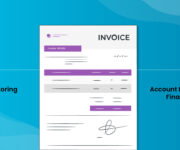Maintaining cash flows efficiently is an important aspect of business growth. Companies budget a certain amount of funds to help meet their production expenses.
However, sometimes, companies may need a sudden influx of cash to help fund an order of a larger ticket size.
This is where access to invoice financing can help them fulfill the order promptly, and accelerate business growth. In the absence of such lending support, businesses may experience an opportunity cost in the long term.
However, before adopting this, lenders must understand the risks and opportunities associated with invoice financing, including its components like factoring and discounting.
Invoice Financing: At a Glance
Invoice financing is a loan product that helps business borrowers fund an outstanding client invoice. With access to such funds, businesses can fulfil invoice-related orders.
Once the business fulfils the order, the client will release the payment. The invoice value appears in the “accounts receivable” category of the business’s balance sheet.
Now, say, a business is unable to fulfil the order due to a lack of access to adequate and timely funding. This scenario then translates to an opportunity cost for the company.
This is where invoice financing can help businesses that face a temporary cash flow issue. With access to timely funds, the borrowers can proceed to fulfil the order and get paid by their clients, faster.
Invoice financing is especially relevant to businesses in the following sectors:
- Manufacturing
- Construction
- Printing
- Logistics
- Wholesale
- Security
- Recruitment
- Transportation
Major Invoice Financing Models
Lenders can take two approaches towards invoice financing, based on the risk profile and needs of a prospective borrow:
1. Invoice Factoring
Invoice factoring is a type of invoice financing model where a business borrower sells its outstanding invoices to a lender. In turn, the lender pays the borrower, up to 70% to 85% of what the invoice is worth, upfront. This amount enables the borrower to cover their production costs.
In this scenario, lenders collect payments directly from customers. Once the lender receives full payment for the invoices, it pays the remaining amount to the business, minus any interest and fees associated with the loan.
2. Invoice Discounting
Invoice discounting is a type of invoice financing model where a business borrower may receive funds of up to 95% of the value of the invoice upfront.
This provides the business with immediate cash flow, allowing them to fulfil customer orders even while waiting for payment.
Once customers pay their invoices, the lender collects the full amount and remits any remaining balance to the business, after deducting the agreed-upon fees and interest.
Invoice Financing: Factoring vs Discounting
Let’s understand the six main differences between these two invoice financing models:
1. Confidentiality
One of the key differences between invoice discounting and invoice factoring is related to loan confidentiality. In the case of invoice factoring, the customer is aware that the project is being financed by a factoring company i.e. the lender.
On the other hand, the loan remains confidential in the case of invoice discounting.
2. Collection of Payment
In invoice factoring, the lender takes on the responsibility of collecting payments directly from the customers, assuming the credit risk associated with the invoices.
On the other hand, in invoice discounting, the borrower retains the responsibility of collecting payments from their customers.
3. Payment of Interest/ Fees
Typically, in an invoice factoring loan, lenders deduct the fees and interest on the loan and then repay the pending invoice amount to the borrower. This transaction is executed only once they receive payments from the customers.
In contrast, the borrower pays the lender the entire principal amount along with interest and fees charged in the case of an invoice discounting loan.
4. Customer Payment Follow-ups
If customers delay payments, the lender follows up in the case of invoice factoring.
When customers delay payments in the case of invoice discounting, the borrower initiates any payment follow-ups.
5. Relevance
Invoice factoring is more suitable for small and medium-sized businesses due to their affordability for the borrower, lower loan ticket size, and economic viability for landers.
Invoice discounting is relevant to medium-size companies looking to scale up quickly and large ventures.
6. Risk Profile
Typically, companies with a higher creditworthiness profile are more suited for the invoice discounting model due to the risks involved for lenders.
First-time borrowers as well as businesses with less creditworthiness and fewer assets are more suited for the invoice factory model.
Invoice Financing: How a Lending Lifecycle Management Software Tool Helps
When adopting this model, selecting the right terms and conditions is an important pillar for success. In this context, lenders can make data-driven decisions by harnessing the right technology.
For instance, by adopting the use of automated lending lifecycle management software, businesses can streamline the lending process.
They can also make accurate underwriting decisions.
In invoice financing, here’s how lenders can reap the benefits of loan management software:
- Strengthen the risk assessment processing by automated, comprehensive, and accurate analysis of financial data.
- Analysing a wider set of data points that include bank statements, credit reports, Goods and Services Tax (GST) tax returns, balance sheets, and invoices.
- AI-powered identification of potential fraud committed via fake documents, fraudulent transactions, and identity theft.
- Automated customisation of loan products based on the real needs and creditworthiness score of borrowers.
Key Takeaway
Access to timely invoice financing can help accelerate growth for businesses of all sizes and scales. Borrowers can range from MSMEs to highly-scaled businesses looking to pivot to the next level.
By responding to this demand, swiftly lenders can capitalise on opportunities. The adoption of superior financial statement analysis technology can help lenders navigate risk more effectively while growing their invoice financing vertical.
Finezza offers a comprehensive set of tools and solutions to manage your lending portfolio. Our end-to-end lending management solutions are trusted by brands like ftcash, Hiranandani Financial Services, gromor Finance, and UC Inclusive Credit, to name a few.
Finezza’s intuitive bank statement analysis software is geared to analyse bank statements with speed, and accuracy and detect potential fraud.
Book a demo to know more.




Leave a Reply